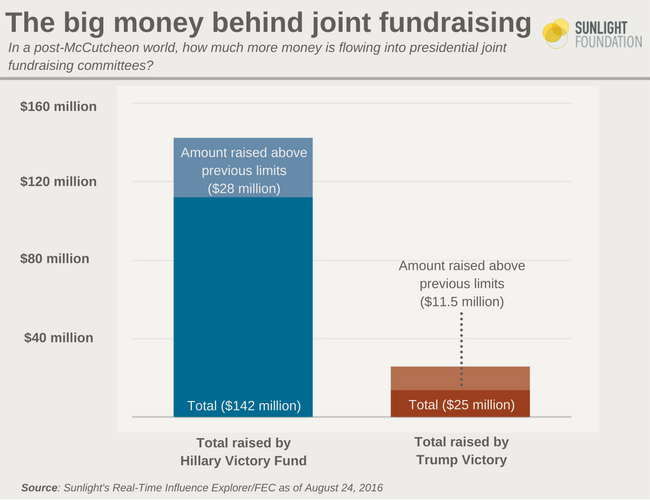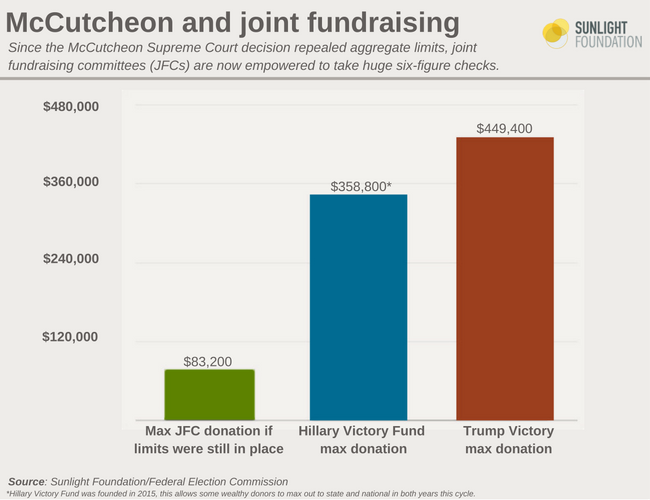McCutcheon decision has allowed at least $39 million more in presidential election so far

In 2014, the Supreme Court’s decision in McCutcheon v. Federal Election Commission (FEC) eliminated the so-called aggregate limits on political contributions, that placed a ceiling on the total amount a single donor could give across campaigns, PACs and federal and state party committees. This, combined with the court’s Citizens United decision, which allowed outside groups to spend unlimited and often untraceable amounts of money on our elections, empowers the wealthiest of donors to give more and more.
And these big donors are taking advantage: Sunlight estimates that at least $39 million more has flowed into the presidential fundraising committees than would have if the aggregate limits still existed today, according to data from the latest FEC filings and Sunlight’s Real-Time Influence Explorer.
Hillary Clinton’s joint fundraising committee, Hillary Victory Fund, which is a partnership between her campaign, the DNC and 33 state parties has raised $142 million total. A least $28 million of that money would not have been available before the McCutcheon decision.
Donald Trump’s joint fundraising committee, Trump Victory, raised a total of $25.6 million according to the latest filings. At least $11.5 million of that is more than he would have been able to raise if the aggregate rules were still in place. Some of the money Trump has raised, though, goes toward special accounts that can only be used for legal, headquarters and convention purposes.
These types of high-dollar JFCs create a one-stop shop for very wealthy donors to contribute and get access to politicians and their high-level staff.
The 2016 election is the first presidential campaign since the McCutcheon decision, and the candidates are exploiting loopholes by using joint fundraising committees (JFCs) to raise bigger-than-ever bucks. Simply put, a JFC is a committee that benefits two or more candidates, PACs or party committees. According to Sunlight’s own Campaign Finance 101 Glossary, “Since McCutcheon v. FEC, donors can contribute as much as they want to these committees, and the money will be split amongst the beneficiaries in accordance with legal limits.” But there’s a reason why JFCs have become so popular recently.
As Sunlight’s Libby Watson noted in June, without aggregate limits in place, a JFC can now raise huge six-figure sums from individual donors with just a single check. One reason these JFCs can raise additional funds is due to a loophole that allows the state parties (like the Alaska Democratic Party or Republican Party of New York) to move money between the state counterparts and the national party.
In 2012, the aggregate limit for all donations was $117,000, and Barack Obama’s JFC was limited to accepting $75,800 total per individual per cycle. Mitt Romney’s JFC could accept similar amounts.
According to Sunlight Foundation estimates based on previous FEC calculations, if the aggregate limits still existed today, the total amount available to give would be pegged at about $127,000. JFCs similar in nature to both Clinton’s and Trump’s would be allowed to accept an estimated $82,300.

McCutcheon empowers big donors to give more and more
Clinton commanded at least 365 donors that were able to give past previous limits. Donors that wrote top-level checks include: Cheryl and Haim Saban, Mary and J.B. Pritzker, Fred Eychaner, George Soros, Steven Spielberg and Donald Sussman, all of whom gave more than $350,000 each. Because Clinton’s JFC was established in 2015, some donors are able to double down, maxing out to the DNC and state parties in both 2015 and 2016. This means donors like the Saban’s were able to give about $712,000 each. View a list of Clinton’s top JFC donors here.
Additionally, an analysis by Bloomberg’s Bill Allison concluded that Clinton and the DNC are really taking advantage of a loophole that allows unlimited transfer of funds between state and national political parties. The report found that “at least $7.3 million of the DNC’s July total originated with payments from hundreds of major donors who had already contributed the maximum $33,400.”
Trump’s JFC has far fewer donors overall, and even fewer who gave over the previous limit — about 68 in total that gave more than $82,300. Donors that maxed out to the committee include Darwin and Katrina Deason, Laura Perlmutter (who is married to Isaac Perlmutter the CEO of Marvel Entertainment), Geniya and Douglas Manchester, all of whom gave $449,400 each — the max allowed to Trump’s JFC. View a list of Trump’s top JFC donors here.
Sunlight estimates there are about 263 joint fundraising committees, and at least 50 have raised more than $100,000 last quarter. During the same reporting period (April-June) those top 50 JFCs raised a collective total of $137 million, with more than $58 million cash on hand. And it is not just the at the presidential level. Speaker Paul Ryan has a JFC, Team Ryan, that is partnered with his leadership PAC, Prosperity Action PAC, his congressional committee and the National Republican Congressional Committee. This campaign committee has raised $15.6 million, and that includes about $7.8 million that is above the max that would have been allowed under a JFC in 2012, before McCutcheon.
It remains to be seen how far and wide the use of JFCs will spread or the use of the state parties loophole, but if 2016 is any indicator, we can only expect more big money into the system.

